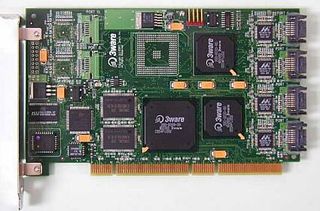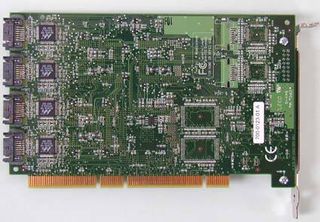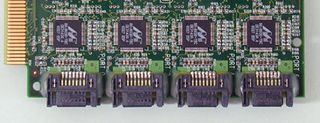RAIDCore Unleashes SATA to Take Out SCSI
3Ware Escalade 8506-8

There is also a 12-channel version, as can be seen from the missing third controller and the empty areas at the top right.Firmware: 7.6.4
The 8506-8 is a development of the 8500 family and now comes with 64 bits and 66 MHz. Previously, 33 MHz was the limit. All SATA controllers from 3Ware are based on an architecture called StorSwitch. As the word suggests, StorSwitch is a kind of packet switching that many of you might be familiar with from the Ethernet area.
It involves each drive communicating autonomously with the controller via what's called a port identifier - here, 3Ware introduces the keywords point-to-point and non-blocking. In contrast to a split bus such as SCSI, it has the advantage that each drive can function simultaneously and independently of the others. This is especially true as it also applies to Version 7506 of UltraATA.
In concrete terms, the required hardware in the Escalade 8506 can be divided into two parts. On the one hand there are the ATA interfaces each supporting four ports, while on the other, we have the actual RISC processor with XOR engine as hardware that also contains the 64 bit PCI interface.
The 3Ware Disk Manager can be used to configure and manage the drive array(s), and it also masters features needed for business use such as e-mail or pager notification of failure.
The 3ware.biz website does not exactly excel through good German - something that doesn't instill the sense of professionalism that 3Ware deserves. We therefore decided to concentrate on the English-language site where 3Ware provides all sorts of information. We like the clear statement that arrays can be a maximum of 2 TB - HighPoint, for example, fails to broach the subject at all.
Besides for RAIDCore, 3Ware also supports several controllers simultaneously. Four of them can be used together. That said, array support does not stretch quite so far, because although an Escalade controller can manage several arrays, they must be located on different hard drives.
Stay on the Cutting Edge
Join the experts who read Tom's Hardware for the inside track on enthusiast PC tech news — and have for over 25 years. We'll send breaking news and in-depth reviews of CPUs, GPUs, AI, maker hardware and more straight to your inbox.

Ports 5-8 are on the reverse. The intended space for two further ports in the 12-channel version is easy to spot (top right).


Gotcha! eight ports, all facing the front.


The loss of one hard drive in a RAID 5 array with eight drives leads to serious reductions in performance. Nevertheless, the rebuild was quickly performed.
Current page: 3Ware Escalade 8506-8
Prev Page LSI MegaRAID 320-2: BIOS And Configuration Next Page 3Ware Escalade 8506: 3DMMost Popular

